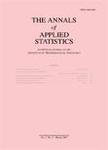-
作者:Warton, David I.; Shepherd, Leah C.
作者单位:University of New South Wales Sydney; University of New South Wales Sydney
摘要:Presence-only data, point locations where a species has been recorded as being present, are often used in modeling the distribution of a species as a function of a set of explanatory variables-whether to map species occurrence, to understand its association with the environment, or to predict its response to environmental change. Currently, ecologists most commonly analyze presence-only data by adding randomly chosen pseudo-absences to the data such that it can be analyzed using logistic regre...
-
作者:Lau, Ada; Mcsharry, Patrick
作者单位:University of Oxford; University of Oxford
摘要:The generation of multi-step density forecasts for non-Gaussian data mostly relies on Monte Carlo simulations which are computationally intensive. Using aggregated wind power in Ireland, we study two approaches of multi-step density forecasts which can be obtained from simple iterations so that intensive computations are avoided. In the first approach, we apply a logistic transformation to normalize the data approximately and describe the transformed data using ARIMA-GARCH models so that multi...
-
作者:Kriegler, Brian; Berk, Richard
作者单位:University of Pennsylvania
摘要:In many metropolitan areas efforts are made to count the homeless to ensure proper provision of social services. Some areas are very large, which makes spatial sampling a viable alternative to an enumeration of the entire terrain. Counts are observed in sampled regions but must be imputed in un-visited areas. Along with the imputation process, the costs of underestimating and overestimating may be different. For example, if precise estimation in areas with large homeless counts is critical, th...
-
作者:Wilson, Melanie A.; Iversen, Edwin S.; Clyde, Merlise A.; Schmidler, Scott C.; Schildkraut, Joellen M.
作者单位:Duke University; Duke University
摘要:Technological advances in genotyping have given rise to hypothesis-based association studies of increasing scope. As a result, the scientific hypotheses addressed by these studies have become more complex and more difficult to address using existing analytic methodologies. Obstacles to analysis include inference in the face of multiple comparisons, complications arising from correlations among the SNPs (single nucleotide polymorphisms), choice of their genetic parametrization and missing data....
